What Characteristic of British Early Medieval Art Appears in English Gothic
| Top: Lincoln Cathedral | |
| Years agile | c. 1175–1640 |
|---|---|
| Country | Kingdom of England |
English Gothic is an architectural style that flourished from the tardily 12th until the mid-17th century.[one] [2] The manner was most prominently used in the construction of cathedrals and churches. Gothic architecture's defining features are pointed arches, rib vaults, buttresses, and extensive utilise of stained glass. Combined, these features immune the creation of buildings of unprecedented height and grandeur, filled with light from large stained glass windows. Important examples include Westminster Abbey, Canterbury Cathedral and Salisbury Cathedral. The Gothic fashion endured in England much longer than in Continental Europe.
The Gothic manner was introduced from France, where the various elements had first been used together within a unmarried building at the choir of the Abbey of Saint-Denis north of Paris, completed in 1144.[3] The earliest big-calibration applications of Gothic architecture in England were Canterbury Cathedral and Westminster Abbey. Many features of Gothic compages had evolved naturally from Romanesque architecture (often known in England as Norman architecture). The outset cathedral in England to be both planned and built entirely in the Gothic way was Wells Cathedral, begun in 1175.[iv] Other features were imported from the Ile-de-France, where the beginning French Gothic cathedral, Sens Cathedral, had been built (1135–64).[5] After a fire destroyed the choir of Canterbury Cathedral in 1174, the French builder William of Sens rebuilt the choir in the new Gothic fashion between 1175 and 1180. The transition can also exist seen at Durham Cathedral, a Norman building which was remodelled with the earliest rib vault known. Besides cathedrals, monasteries, and parish churches, the style was used for many secular buildings, including academy buildings, palaces, bang-up houses, and almshouses and guildhalls.
Stylistic periodisations of the English Gothic style are
- Early English or First Pointed (late 12th–tardily 13th centuries)
- Decorated Gothic or Second Pointed (late 13th–late 14th centuries)
- Perpendicular Gothic or Third Pointed (14th–17th centuries).[6] [7]
The architect and fine art historian Thomas Rickman's Attempt to Discriminate the Style of Compages in England, kickoff published in 1812, divided Gothic architecture in the British Isles into iii stylistic periods.[eight] Rickman identified the period of compages as follows:
- William the Conqueror ( r. 1066–87) to Henry Ii ( r. 1154–89) as Norman
- Richard the Lionheart ( r. 1189–99) to Edward I ( r. 1272–1307) every bit Early English
- reigns of Edward II ( r. 1307–27) and Edward III ( r. 1327–77) as Decorated
- from Richard II ( r. 1377–99) to Henry VIII ( r. 1509–47) as Perpendicular [eight]
From the 15th century, under the House of Tudor, the prevailing Gothic style is commonly known every bit Tudor architecture. This fashion is ultimately succeeded past Elizabethan compages and Renaissance architecture nether Elizabeth I ( r. 1558–1603).[9] Rickman excluded from his scheme most new buildings after Henry VIII's reign, calling the style of "additions and rebuilding" in the later 16th and earlier 17th centuries "oftentimes much debased".[8]
Builder and art historian Edmund Sharpe, in The Seven Periods of English Architecture (1851), identified a pre-Gothic Transitional Period (1145–xc), post-obit the Norman menstruum, in which pointed arches and circular arches were employed together.[x] Focusing on the windows, Sharpe dubbed Rickman's Gothic styles as follows:
- Rickman's first Gothic way every bit the Lancet Flow (1190–1245)
- Rickman's 2d Gothic style divided into the Geometrical period (1245–1315) and and then the Curvilinear menstruum (1315–1360)
- Rickman's third fashion as the Rectilinear menses (1360–1550).[10] Unlike the Early English and Decorated styles, this 3rd style, employed over three centuries was unique to England.
In the English Renaissance, the stylistic linguistic communication of the ancient classical orders and the Renaissance compages of southern Europe began to supersede Gothic architecture in Continental Europe, only the British Isles continued to favour Gothic building styles, with traditional Perpendicular Gothic edifice projects undertaken into the 17th century in England and both Elizabethan and Jacobean architecture incorporating Gothic features, especially for churches.[xi]
Classical-inspired architecture predominated after the Keen Fire of London The rebuilding of the Metropolis of London was so extensive that the numbers of workers employed broke the monopoly of the medieval livery visitor of stonemasons and the Worshipful Company of Masons and the role of chief-mason was displaced by that of the early modern architect.[11] The new St Paul'southward Cathedral designed past Christopher Wren and his Wren churches generally dispensed with the Gothic idiom in favour of classical work.[11] Outside London however, new ecclesiastical buildings and repairs to older churches were still carried out in Gothic style, particularly near the aboriginal university towns of Oxford and Cambridge, where the university colleges were of import patrons of 17th-century Gothic structure.[11]
By the 18th century, architects occasionally worked in Gothic style, but the living tradition of Gothic workmanship had faded and their designs rarely resembled medieval Gothic buildings. Just when the Gothic Revival movement of the late 18th and 19th centuries began, was the architectural language of medieval Gothic relearned through the scholarly efforts of early 19th-century art historians like Rickman and Matthew Bloxam, whose Principles of Gothic Ecclesiastical Architecture first appeared in 1829.[12] [eleven]
Alongside the new Gothic building piece of work of the 19th century, many of England'south existing Gothic buildings were extensively repaired, restored, remodelled, and rebuilt by architects seeking to improve the buildings co-ordinate to the Romantic, high church aesthetic of the Oxford Motility and to replace many of the medieval features lost in the iconoclastic phases of the Reformation, the Dissolution of the Monasteries, and the Wars of the 3 Kingdoms. In the process of this Victorian "restoration", much of the original Gothic architecture of the Heart Ages was lost or contradistinct beyond recognition. However, medieval works left unfinished were often completed or restored to their "original" designs. Co-ordinate to James Stevens Curl, the revival of Gothic compages was "arguably, the nigh influential creative phenomenon ever to spring from England".[11]
The diverse English language Gothic styles are seen at their most fully developed in cathedrals, monasteries, and collegiate churches. With the exception of Salisbury Cathedral, English cathedrals–having building dates that typically range over 400 years–show groovy stylistic diversity.
Early English language Gothic (late 12th–tardily 13th centuries) [edit]
Early English language Gothic predominated from the late 12th century until midway to late in the 13th century,[xiii] [14] [15] It succeeded Norman Architecture, which had introduced early on great cathedrals, congenital of rock instead of timber, and saw the structure of remarkable abbeys throughout England. The Normans had introduced the three classical orders of architecture, and created massive walls for their buildings, with thin pilaster-similar buttresses. The transition from Norman to Gothic lasted from nearly 1145 until 1190. In the reigns of Male monarch Stephen and Richard I, the way changed from the more massive severe Norman style to the more than delicate and refined Gothic.[16]
Early on English language was particularly influenced by what was called in English "The French style".[ citation needed ] The fashion was imported from Caen in Normandy by French Norman architects, who besides imported cut stones from Normandy for their construction. Information technology was also influenced by the architecture of the Ile-de-France, where Sens Cathedral had been constructed, the kickoff Gothic cathedral in France. The chancel of Canterbury Cathedral, one of the first Early English structures in England, was rebuilt in the new manner by a French architect, William of Sens.[17]
The Early English style particularly featured more strongly-constructed walls with rock vaulted roofs, to resist burn down. The weight of these vaults was carried downwards and outwards by biconvex ribs. This characteristic, the early rib vault, was used at Durham Cathedral, the first time it was used this way in Europe.[18]
Another important innovation introduced in this early on period was the buttress, a stone column exterior the structure that reinforced the walls against the weight pressing outward and downward from the vaults. This evolved into the flight buttress, which carried the thrust from the wall of the nave over the roof of the alley. The buttress was given further support by a heavy stone pinnacle. Buttresses were an early characteristic of the chapter firm of Lichfield Cathedral.[sixteen]
Early on English language is typified by lancet windows, alpine narrow lights topped by a pointed arch. They were grouped together side past side under a single arch and decorated with mullions in tracery patterns, such as cusps, or spear-points. Lancet windows were combined similarly pointed arches and the ribs of the vaults overhead, giving a harmonious and unified style.
Characteristics [edit]
- The vertical plan of early Gothic Cathedrals had iii levels, each of about equal height; the clerestory, with arched windows which admitted light on top, under the roof vaults; the triforium a wider covered arcade, in the middle; and, on the ground floor, on either side of the nave, wide arcades of columns and pillars, which supported the weight of the ceiling vaults through the ribs.
- The virtually distinctive element of this period was the pointed arch, (besides known every bit the lancet arch, which was the fundamental feature of the Gothic rib vault, The original purpose of rib vault was to allow a heavier stone ceiling, to supercede the wooden roofs of the earlier Norman churches, which frequently caught fire. They also had the benefit of allowing the structure of college and thinner walls. They appeared first in an early form in Durham Cathedral.[18] Gradually, pointed arches were used not only for rib vaults, but as well for all of the arcades and for lancet windows, giving the nave its unified appearance. The first structure in England to be built entirely with the pointed arch was Wells Cathedral (1175–1260), simply they were before long used in all Cathedrals.[nineteen]
- The Early on English language rib vaults were usually quadripartite, each having four compartments divided past ribs, with each covering i bay of the ceiling. The horizontal ridge ribs intersected the summits of the cross ribs and diagonal ribs, and carried the weight outwards and downward to pillars or columns of the triforium and arcades, and, in later cathedrals, outside the walls to the buttresses.[20]
- The lancet window, narrow and tall with a point at the elevation, became a common feature of English architecture. For this reason, Early on English language Gothic is sometimes known every bit the Lancet style. The Lancet openings of windows and decorative arcading are often grouped in twos or threes. This feature is seen throughout Salisbury Cathedral, where groups of ii lancet windows line the nave and groups of three line the clerestory. At York Minster the north transept has a cluster of five lancet windows known as the 5 Sisters; each is 50 feet tall and still retains its original glass.
- Stained glass windows began to exist widely used in the windows of the clerestory, transept and particularly west façade. Many were elaborately decorated with tracery; that is, thin mullions or ribs of rock which divided the windows into elaborate geometric patterns. as at Lincoln Cathedral (1220).
- Rose Windows were relatively rare in England, but Lincoln Cathedral has two notable examples from this menstruation. The oldest is the Dean's Window in the north transept, which dates to 1220–1235. Information technology is an example of an Early on English plate-tracery rose window. The geometric blueprint, with concentric tiers of circular window lights, predates the geometric tracery of the later decorated style of Gothic architecture. The principal theme of the window is the second coming of Christ and the terminal sentence. Some scenes are associated with death and resurrection, such every bit the funeral of Saint Hugh, the founder of the cathedral, and the decease of the Virgin.[21]
- Foursquare east end. The typical arrangement for an English Gothic eastward finish is square, and may be an unbroken cliff-like blueprint as at York, Lincoln, Ripon, Ely and Carlisle or may have a projecting Lady Chapel of which at that place is a great variety equally at Salisbury, Lichfield, Hereford, Exeter and Chichester.
- Sculptural decoration. Unlike the more sombre and heavy Norman churches, the Gothic churches began to accept elaborate sculptural decoration. The arches of the arcades and triforium were sometimes busy with dog tooth patterns, cusps, carved circles, and with trefoils, quatrefoils, too as floral and vegetal designs. Simple floral motifs also ofttimes appeared on the capitals, the spandrels, the roof boss that joined the ribs of the vaults.[14]
- The clustered cavalcade. Instead of being massive, solid pillars, early Gothic columns were frequently composed of clusters of slender, detached shafts, which descended the vaults above. These were often made of nighttime, polished Purbeck "marble", surrounding a key pillar, or pier, to which they are attached past circular moulded shaft-rings. One characteristic of Early on Gothic in England is the not bad depth given to the hollows of the mouldings with alternating fillets and rolls, and by the decoration of the hollows with the domestic dog-tooth ornament and past the round abacus or tops of the capitals of the columns.[fourteen]
Examples [edit]
- the east stop of Canterbury Cathedral (1174–84) rebuilt past French masons following a fire
- transept, nave and west front of Wells Cathedral (1176–1260; western towers added in the Perpendicular period, 1365–1435)
- clerestory and vaults of Chichester Cathedral (1187–99)
- retro-choir at Winchester Cathedral (1189–93; not including the Lady chapel)
- Lincoln Cathedral and affiliate house (1192–1255; Not including the "Angel Choir", south transept, towers, and cloisters)
- eastward stop and transept of Rochester Cathedral (1200–27)
- westward front of Peterborough Cathedral (1200–22)
- the east end of Worcester Cathedral (1202–18)
- at Hereford Cathedral; the Lady chapel (1217–25) and upper part of the choir (1235–xl)
- Salisbury Cathedral (1220–1266; not including Decorated primal tower, 1334–80 and Perpendicular crossing arches, 1388–95)
- bang-up transept of York Minster (1226–55)
- east end of Southwell Minster (1234–fifty)
- eastward end of Ely Cathedral (1234–54)
- presbytery of St. Albans Cathedral (1235–50)
- the chapter house at Lichfield Cathedral (1239–49)
- Chapel of Ix Altars at Durham Cathedral (1242–80)
- at Chester Cathedral; the chapter house (1249–65) and Lady chapel (1265–90)
- Whitby Abbey
- Rievaulx Abbey
Busy Gothic (belatedly 13th–tardily 14th centuries) [edit]
The 2d style of English Gothic architecture is generally termed Decorated Gothic, because the amount of ornamentation and decoration increased dramatically. It corresponded roughly with the Rayonnant period in France, which influenced it. It was a menses of growing prosperity in England, and this was expressed in the decoration of Gothic buildings. Almost every feature of the interiors and facades was decorated.
- Geometric Decorated
-
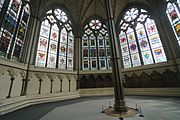
-
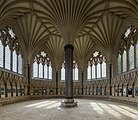
-

-
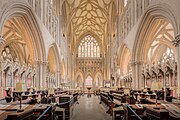
-
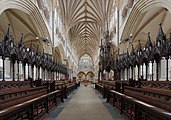
-

-
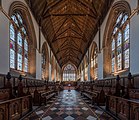
-
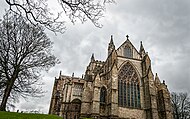
-

-

-

Historians sometimes subdivide this style into two periods, based on the predominant motifs of the designs. The first, the Geometric style, lasted from well-nigh 1245 or fifty until 1315 or 1360, where ornament tended to be based on straight lines, cubes and circles, followed by the Curvilinear style (from about 1290 or 1315 until 1350 or 1360) which used gracefully curving lines.[22]
- Curvilinear Decorated
-

-
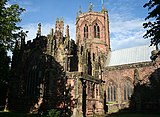
-

-

-
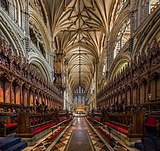
-
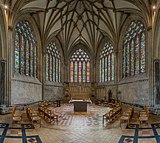
-
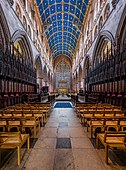
-
Prior Crauden'south Chapel, Ely
-
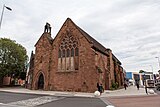
Additions in the Busy style were oft added to earlier cathedrals. One striking case is constitute at Ely Cathedral; the architect Thomas Witney built the central tower from 1315 to 1322 in Busy mode. Soon afterward another architect, William Joy, added curving arches to strengthen the structure, and fabricated further extensions to join the Lady Chapel to the Choir. In 1329–45 he created an extraordinary double arch in the decorated mode.[23] [ better source needed ]
Characteristics [edit]
- Lierne vaulting. Vaulting became much more than elaborate in this menstruation. The rib vault of earlier Early Gothic usually had only iv compartments, with a minimum number of ribs which were all connected to the columns below, and all played a role in distributing the weight and outwards and down. In the Busy compages period, additional ribs were added to the vaulted ceilings which were purely decorative. They created very elaborate star patterns and other geometric designs. Gloucester Cathedral and Ely Cathedral accept notable lierne vaults from this menses.[xx]
The buttress became more mutual in this period, as at Lichfield Cathedral. These were stone columns outside the walls which supports them, allowing thinner and high walls between the buttresses, and larger windows. The buttresses were often topped by ornamental rock pinnacles to give them greater weight.
- Fan vaulting. An fifty-fifty more elaborate form, appeared late in the Decorative. Different the lierne vault, the fan vault had no functional ribs; the visible "ribs" are mouldings on the masonry imitating ribs. The structure is composed of slabs of stone joined into half-cones, whose vertices are the springers of the vault. The earliest example, from 1373, is found in the cloisters of Gloucester Cathedral. Information technology made a notable backdrop in some of the Harry Potter films.[20]
- Tracery. Busy architecture is particularly characterised by the elaborate tracery within the stained glass windows. The elaborate windows are subdivided by closely spaced parallel mullions (vertical bars of stone), ordinarily up to the level at which the arched top of the window begins. The mullions then branch out and cross, intersecting to fill the tiptop part of the window with a mesh of elaborate patterns called tracery, typically including trefoils and quatrefoils. The style was geometrical at first and curvilinear, or curving and serpentine, in the afterwards period, This curvilinear chemical element was introduced in the get-go quarter of the 14th century and lasted almost fifty years.[24] A notable example of the curvilinear style is the E window of Carlisle Cathedral, (about 1350). Some other notable example of decorated curvilinear is the w window of York Minster (1338–39).[25]
- Sculpture too became more ornate and decorative. The brawl flower and a iv-leaved bloom motif took the identify of the earlier dog-tooth. The foliage in the capitals was less conventional than in Early English and more flowing, Another decorative feature of the period was diapering, or creating multi-color geometric patterns on walls or panels made with different colours of stone or brick.[24]
-

The octagon and lantern, Ely Cathedral, rebuilt following the collapse of the central belfry in 1321
-
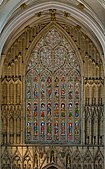
The great w window of York Minster (1338–39), featuring a motif known as the Centre of Yorkshire
Examples [edit]
- Westminster Abbey (transitional; 1245–72, eastward finish, transept & chapter firm; 1376–1400, nave)
- choir of Carlisle Cathedral (transitional; 1245–1398)
- at Hereford Cathedral; n transept (transitional; 1245–68) and central tower (1300–10)
- at Lincoln Cathedral; the Affections Choir and east stop (1256–fourscore), cloisters (ca. 1295), cardinal tower (1307–xi), and upper office of the southward transept, including the Bishop'southward Centre window (ca. 1320–thirty)
- at Lichfield Cathedral; the nave and westward front (1265–93), fundamental tower (ca. 1300) and Lady Chapel (1320–36)
- Footling Wenham Hall, Suffolk (1270–80)
- St Wulfram's Church, Grantham (1280–1350)
- Merton College chapel, Oxford (1289–96; tower and ante-chapel added 1424–fifty)
- at York Minster; the chapter business firm (1260–96), nave and w forepart, including the Middle of Yorkshire window (1291–1375)
- at Wells Cathedral; the chapter house (1275–1310), eastward end (1310–nineteen, Lady chapel; 1329–45, choir and retro-choir), cardinal tower (1315–22) and strainer arches (1415–23)
- the affiliate house at Salisbury Cathedral (1275–85)
- east end of Bristol Cathedral (1298–1340)
- at Southwell Minster; the chapter business firm (1293–1300), and pulpitum (1320–35)
- the Lady chapel at St. Albans Cathedral (1308–26)
- the chapel of Alnwick Castle (1309–50)
- the nave and westward forepart at Worcester Cathedral (1317–95)
- at Ely Cathedral; the Lady chapel (1321–49; east window, 1371–74) and the octagon, lantern and westward bays of nave (1322–62)
- the nave and west front at Exeter Cathedral (1328–42; Epitome Screen added 1346–75)
- The Lady Chapel at Melrose Abbey Scotland,[24]
Perpendicular Gothic (late 13th to mid 16th century) [edit]
The Perpendicular Gothic (or simply Perpendicular) is the third and final manner of medieval Gothic architecture in England. It is characterised by an emphasis on vertical lines, and is sometimes called rectilinear.[26] [27] The Perpendicular mode began to emerge in about 1330. The primeval example is the chapter house of Onetime St Paul'southward Cathedral, congenital by the imperial architect William de Ramsey in 1332.[28] The early style was also practised by another royal architect, John Sponlee, and fully developed in the works of Henry Yevele and William Wynford.
Walls were congenital much college than in before periods, and stained drinking glass windows became very big, so that the infinite around them was reduced to simple piers. Horizontal transoms sometimes had to be introduced to strengthen the vertical mullions.[29]
Many churches were built with magnificent towers including York Minster, Gloucester Cathedral, Worcester Cathedral, and St Botolph's Church, Boston, St Giles' Church, Wrexham, St Mary Magdalene, Taunton. Some other outstanding example of Perpendicular is King's College Chapel, Cambridge.[thirty]
The interiors of Perpendicular churches were filled with lavish ornamental woodwork, including misericords (choir stalls with lifting seats), nether which were grotesque carvings; stylized "poppy heads", or carved figures in leaf on the ends of benches; and elaborate multicoloured decoration, usually in floral patterns, on panels or cornices called brattishing.[29] The sinuous lines of the tracery in the Decorated style were replaced by more geometric forms and perpendicular lines.[31]
The style was also affected by the tragic history of the period, particularly the Black Expiry, which killed an estimated third of England's population in 18 months betwixt June 1348 and Dec 1349 and returned in 1361–62 to impale another 5th. This had a neat effect on the arts and culture, which took a more sober direction.[32]
The perpendicular Gothic was the longest of the English Gothic periods; it connected for a century after the style had nearly disappeared from France and the rest of the European continent, where the Renaissance had already begun. Gradually, nigh the end of the period, Renaissance forms began to appear in the English Gothic. A rood screen, a Renaissance ornament, was installed in the chapel of King'due south College Chapel, Cambridge. During the Elizabethan Period (1558–1603), the classical details, including the five orders of classical architecture, were gradually introduced. Carved ornamentation with Italian Renaissance motifs began to exist used in ornament, including on the tomb of Henry VII in Westminster Abbey. The pointed arch gradually gave way to the Roman rounded arch, brick began to supersede masonry, the roof construction was concealed, and the Gothic finally gave way to an imitation of Roman and Greek styles.[29]
Characteristics [edit]
-

The choir of Gloucester Cathedral conveys an impression of a "cage" of rock and glass. Window tracery and wall decoration class integrated grids.
-
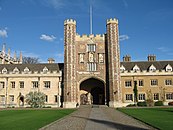
- Towers were an of import feature of the perpendicular style, though fewer spires were congenital than in earlier periods. Important towers were built at Gloucester Cathedral, York Minster, Worcester Cathedral, and on many smaller churches. Decorative Battlements were a popular decoration of towers in smaller churches.
- Windows became very large, sometimes of immense size, with slimmer stone mullions than in earlier periods, allowing greater telescopic for stained glass craftsmen. The mullions of the windows are carried vertically up into the arch moulding of the windows, and the upper portion is subdivided past boosted mullions (supermullions) and transoms, forming rectangular compartments, known as panel tracery. The Tudor Arch window was a particular feature of English language Gothic.
- Buttresses and wall surfaces were divided into vertical panels.[31]
- Doorways were oftentimes enclosed within a foursquare head over the curvation mouldings, the spandrels being filled with quatrefoils or tracery.[31] Pointed arches were still used throughout the period, only ogee and 4-centred Tudor arches were likewise introduced.
- Within the church the triforium disappeared, or its place was filled with panelling, and greater importance was given to the clerestory windows, which oftentimes were the finest features in the churches of this menstruum. The mouldings were flatter than those of the earlier periods, and i of the primary characteristics is the introduction of large elliptical hollows.[31]
- Flint architecture. In areas of Southern England using flint compages, elaborate flushwork decoration in flint and ashlar was used, especially in the wool churches of East Anglia.
Examples [edit]
- at Gloucester Cathedral; the choir and transepts (1330–74, remodel of Norman work), cloisters (1370–1412), west front, western nave vaults, and due south porch (1421–37), tower (1450–67) and Lady chapel (1457–83)
- at York Minster; the e end (1340–1408), central tower (1420–72), Kings Screen (1420–22) and w towers (1433–72)
- at Winchester Cathedral; the west front (1346–66), and nave (1399–1419, remodel of Norman work)
- at Norwich Cathedral; the clerestory of the presbytery (1362–69; transitional in fashion), and vaults (1446–72, nave; 1472–99, presbytery; 1501–36, transepts)
- at Worcester Cathedral, the central belfry (1374) and cloisters (1375–1438)
- at Canterbury Cathedral; the nave, w front and cloisters (1379–1414), affiliate house (1400–12), transepts (1404–fourteen, south; 1470–82, due north), pulpitum (1410–39), southwest belfry (1423–34; northwest tower added 1834–41), and cardinal tower (1493–97)
- New College, Oxford (1380–1400; including chapel, hall, Smashing Quad, cloisters and bell-tower)
- the chapel of Winchester College, Hants. (1387–94)
- Manchester Cathedral (1422)
- Divinity School, Oxford (1427–83)
- Front Quad and chapel of All Souls College, Oxford (1438–42)
- Eton College Chapel, Eton (1441–82)[33]
- King'due south College Chapel, Cambridge (1446–1515)[34]
- Old Court, hall and chapel of Queens' College, Cambridge (1448–49)
- Magdalen College, Oxford (1474–90, including former library, chapel, cloisters, and founder'southward tower; Magdalen Belfry congenital 1492–1509)
- Collegiate Church of the Holy Trinity, Tattershall, Lincolnshire (c. 1490 – 1500)[35])
- choir of Sherborne Abbey (1475 – c. 1580)
- presbytery and lady chapel at Winchester Cathedral (1493–1500)
- at Chester Cathedral; the south transept, western forepart, key tower and cloisters (1493–1530)
- the retro-choir at Peterborough Cathedral (1496–1508)
- Bath Abbey (1501–39)
- Towers of St Giles' Church building, Wrexham, and St Mary Magdalene, Taunton (1503–1508)
- the Henry 7 Lady Chapel at Westminster Abbey (1503–09; heavily restored in the 1860s)
- *Outset Court, Christ'due south College, Cambridge (1505–11; including chapel and hall)
- Starting time Quad (1511–20, including hall) & 2d Quad (1598–1602), St. John's College, Cambridge
- Front Quad, Corpus Christi College, Oxford (1515–et seq.; including hall & chapel)
- Tom Quad, Christ Church building, Oxford (1525–29, including slap-up hall)
- Bang-up Court, Trinity College, Cambridge (1599–1608; including hall and chapel)
Roofs [edit]
-
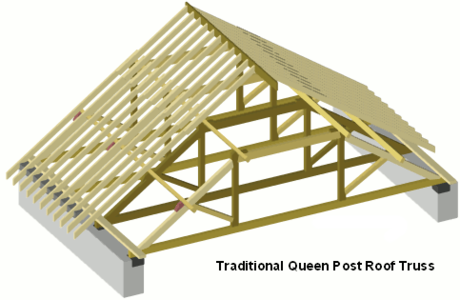
A Queen-post truss
-

-
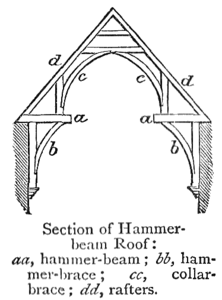
Section of a Hammerbeam timber roof.
-
The pitched Gothic timber roof was a distinctive characteristic of the style, both in religious and domestic architecture. Information technology had to be able to resist rain, snowfall and high winds of the English climate, and to preserve the integrity of the structure. A pitched roof was a common feature of all the Gothic periods. During the Norman period, the roofs usually were pitched forty-five degrees, with the apex forming a right angle, which harmonised with the rounded arches of the gables. With the arrival of the pointed rib vault, the roofs became steeper, up to 60 degrees. In the tardily perpendicular flow, the bending declined to xx degrees or even less. The roofs were usually fabricated of boards overlaid with tiles or sheet-lead, which was ordinarily used on low-pitched roofs.[36]
The simpler Gothic roofs were supported past long rafters of low-cal forest, resting on wooden trusses ready into the walls. The rafters were supported by more solid beams, chosen purlins, which were carried at their ends past the roof trusses. The tie-beam is the primary axle of the truss. After, the roof was supported by structures called a Male monarch-point-truss and Queen-post truss, where the principal rafters are continued with the tie axle by the head of the truss. The King-Point truss has a vertical beam with connects the center of the rafter to the ridge of the roof, supported past diagonal struts, while a Queen-Post truss has a wooden collar below the pointed arch which united the posts and was supported by struts and cross-braces. A Queen-Mail truss could bridge a width of forty feet. Both of these forms created greater stability, but the total weight of the roof still came downwardly directly onto the walls.[36]
Gothic architects did non like the roof truss systems, because the numerous horizontal beams crossing the nave obstructed the view of the soaring height. They came up with an ingenious solution, the Hammerbeam roof. In this organisation, the point of the roof is supported by the collar and trusses, but from the collar curved beams attain well downward on the walls, and comport the weight downward and outwards, to the walls and buttresses, without obstructing the view. The oldest existing roof of this kind is found in Winchester Cathedral. The most famous example of the Hammerbeam roof is the roof of Westminster Hall (1395), the largest timber roof of its time, congenital for royal ceremonies such as the banquets following the coronation of the King. Other notable wooden roofs included those of Christ Church building, Oxford, Trinity College, Cambridge, and Crosby Hall. A similar organisation, with arched trusses, was used in the roof of Wexham Cathedral.[36]
Academy Gothic [edit]
The Gothic style was adopted in the tardily 13th to 15th centuries in early English language university buildings, due in role to the close connection betwixt the universities and the church. The oldest existing example of University Gothic in England is probably the Mob Quad of Merton Higher, Oxford, constructed betwixt 1288 and 1378.[37] [ page needed ] Balliol College, Oxford has examples of Gothic piece of work in the due north and west ranges of the front quadrangle, dated to 1431; notably in the medieval hall on the west side, (now the "new library") and the "old library" on the starting time flooring, north side. The compages at Balliol was oft derived from castle architecture, with battlements, rather than from church models. King's College Chapel, Cambridge also used another distinctive Perpendicular Gothic feature, the 4-centred arch.
Gothic Revival (19th and 20th centuries) [edit]
The Perpendicular way was less often used in the Gothic Revival than the Decorated style, but major examples include the rebuilt Palace of Westminster (i.east. the Houses of Parliament), Bristol University'southward Wills Memorial Edifice (1915–25), and St. Andrew's Cathedral, Sydney.
See as well [edit]
- Architecture of the medieval cathedrals of England
- Building a Gothic cathedral
- Cathedral architecture of Western Europe
- Collegiate Gothic
- English Gothic stained glass windows
- French Gothic architecture
- Gothic Revival compages
- Poor Human being'southward Bible
References [edit]
- ^ Curl, James Stevens; Wilson, Susan, eds. (2015), "Perpendicular", A Lexicon of Compages and Mural Architecture (3rd ed.), Oxford Academy Printing, doi:10.1093/acref/9780199674985.001.0001, ISBN978-0-nineteen-967498-5 , retrieved 16 May 2020
- ^ Fraser, Murray, ed. (2018), "Perpendicular Gothic", Sir Banister Fletcher Glossary, Imperial Institute of British Architects and the University of London, doi:x.5040/9781350122741.1001816, ISBN978-1-350-12274-ane , retrieved 26 August 2020,
English language idiom from about 1330 to 1640, characterised past large windows, regularity of ornate detailing, and grids of panelling that extend over walls, windows and vaults.
- ^ Honour, Hugh; Fleming, John (2009). A World History of Art (7th ed.). London: Laurence King Publishing. p. 376. ISBN9781856695848.
- ^ Harvey, John Hooper (1987) [1984]. English Mediaeval Architects: A Biographical Dictionary Downwardly to 1550: including master masons, carpenters, carvers, building contractors and others responsible for blueprint. Oswald, Arthur (Revised ed.). Gloucester: Sutton. p. xix. ISBN0-86299-452-seven. OCLC 16801898.
- ^ Mignon, Olivier (2015). Compages des Cathédrales Gothiques. pp. 10–11.
- ^ Schurr, Marc Carel (2010), Bork, Robert E. (ed.), "art and compages: Gothic", The Oxford Lexicon of the Centre Ages, Oxford Academy Press, doi:ten.1093/acref/9780198662624.001.0001, ISBN978-0-19-866262-four , retrieved 9 April 2020,
Early on to High Gothic and Early English (c.1130–c.1240) Rayonnant Gothic and Busy Mode (c.1240–c.1350) Late Gothic: flamboyant and perpendicular (c.1350–c.1500)
- ^ Curl, James Stevens; Wilson, Susan, eds. (2015), "Gothic", A Dictionary of Architecture and Landscape Compages (third ed.), Oxford University Press, doi:10.1093/acref/9780199674985.001.0001, ISBN978-0-19-967498-5 , retrieved 9 Apr 2020,
Offset Pointed (Early on English) was used from the end of C12 to the finish of C13, though almost of its characteristics were present in the lower part of the chevet of the Abbey Church building of St-Denis, near Paris (c.1135–44). ... Once Offset Pointed evolved with Geometrical tracery, it became known equally Middle Pointed. 2d-Pointed work of C14 saw an ever-increasing invention in bar-tracery of the Curvilinear, Flowing, and Reticulated types, ... culminating in the Flamboyant style (from c.1375) of the Continent. Second Pointed was relatively short-lived in England, and was superseded by Perp[endicular] (or Third Pointed) from c.1332, although the 2 styles overlapped for some time.
- ^ a b c Rickman, Thomas (1848) [1812]. An Attempt to Discriminate the Styles of Architecture in England: From the Conquest to the Reformation (5th ed.). London: J. H. Parker. pp. lxiii.
- ^ Curl, James Stevens; Wilson, Susan, eds. (2015), "Tudor", A Dictionary of Architecture and Mural Compages (3rd ed.), Oxford University Press, doi:ten.1093/acref/9780199674985.001.0001, ISBN978-0-19-967498-5 , retrieved 9 April 2020
- ^ a b Sharpe, Edmund (1871) [1851]. The Seven Periods of English Architecture Defined and Illustrated. London: E. & F. North. Spon. p. 8.
- ^ a b c d e f Curl, James Stevens (2016) [2013]. "Architecture, Gothic Revival". In Hughes, William; Punter, David; Smith, Andrew (eds.). The Encyclopedia of the Gothic, 2 Volume Set. Chichester: John Wiley & Sons. pp. twoscore–45. ISBN978-1-119-06460-ii.
- ^ Bloxam, Matthew Holbeche (2015) [1829]. The Principles of Gothic Ecclesiastical Compages: With an Explanation of Technical Terms, and a Centenary of Ancient Terms (definitive 1882 ed.). Cambridge Academy Press. ISBN978-1-108-08270-nine.
- ^ According to the originator of the term in 1817, Thomas Rickman, the period ran from 1189 to 1307.
- ^ a b c One or more of the preceding sentences incorporates text from a publication now in the public domain:Spiers, Richard Phené (1911). "Early English Period". In Chisholm, Hugh (ed.). Encyclopædia Britannica. Vol. viii (11th ed.). Cambridge University Press. p. 798.
- ^ Some sources utilise the dates 1189 to 1272. Smith 1922, pp. 35–45
- ^ a b Smith 1922, pp. 35–45.
- ^ Encyclopaedia Britannica on-line edition, William of Sens (retrieved April nineteen, 2020)
- ^ a b "Durham Earth Heritage Site". UN. Archived from the original on 3 August 2019. Retrieved 29 Oct 2019.
- ^ Bechmann 2017, p. 295.
- ^ a b c Smith 1922, pp. 71–73.
- ^ "Dwelling". Lincoln Cathedral.
- ^ Smith 1922, pp. 45–47.
- ^ Harvey 1987, p. 163.
- ^ a b c This article incorporates text from a publication now in the public domain:Spiers, Richard Phené (1911). "Decorated Period". In Chisholm, Hugh (ed.). Encyclopædia Britannica. Vol. seven (11th ed.). Cambridge University Press. p. 915.
- ^ "Work Minster Fact Sheets: The Five Sisters Window" (PDF). Archived from the original (PDF) on 15 Nov 2017. Retrieved 24 August 2020.
- ^ Sharpe, Edmund (1871). The Seven Periods of English Architecture Defined and Illustrated. Due east. and F. N. Spon; [etc ., etc.]
- ^ Frankl, Paul (2000). Gothic Architecture . Yale: Yale University Press. pp. 193.
- ^ Harvey (1978) puts the earliest instance of a fully formed Perpendicular style at the affiliate house of Old St Paul's Cathedral, in 1332
- ^ a b c Smith 1922, pp. 53–62.
- ^ Harvey, John (1978). The Perpendicular Style. Batsford.
- ^ a b c d I or more than of the preceding sentences incorporates text from a publication now in the public domain:Spiers, Richard Phené (1911). "Perpendicular Menstruum". In Chisholm, Hugh (ed.). Encyclopædia Britannica. Vol. 21 (11th ed.). Cambridge University Press. pp. 179–180.
- ^ This figure has recently been disputed and is now idea to be closer to 20%. Philip Daileader, The Late Middle Ages, audio/video class produced by The Educational activity Visitor, (2007) ISBN 978-1-59803-345-viii.
- ^ "Our History | Eton College". www.etoncollege.com.
- ^ "Chapel | King's College, Cambridge". xxx Nov 2012. Archived from the original on 30 November 2012.
- ^ "TATTERSHALL - The Collegiate Holy Trinity Church building, Tattershall, Lincolnshire - HTTF Trust". 15 Apr 2012. Archived from the original on fifteen April 2012.
- ^ a b c Smith 1922, pp. 63–71.
- ^ Martin 1997. sfn error: no target: CITEREFMartin1997 (help)
Bibliography [edit]
- Bechmann, Roland (2017). Les Racines des Cathédrals (in French). Paris: Payot. ISBN978-two-228-90651-7.
- Ducher, Robert, Caractéristique des Styles, (1988), Flammarion, Paris (in French); ISBN 2-08-011539-ane
- Harvey, John (1961). English Cathedrals. Batsford. OCLC 2437034.
- Smith, A. Freeman (1922). English Church Compages of the Middle Ages - an Uncomplicated Handbook. T. Fisher Unwin.
- Martin, G. H.; Highfield, J. R. L. (1997). A history of Merton College, Oxford. Oxford: Oxford University Press. ISBN0-19-920183-viii.
External links [edit]
- Britain Express: Decorated Gothic architecture
- Britain Express – Architectural Guide
- Great britain Express – Architectural Guide
Source: https://en.wikipedia.org/wiki/English_Gothic_architecture
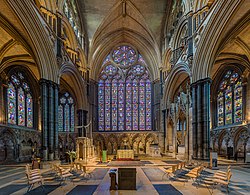




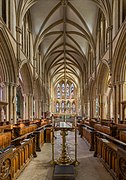
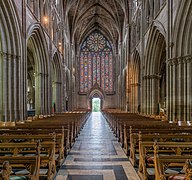


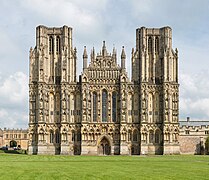
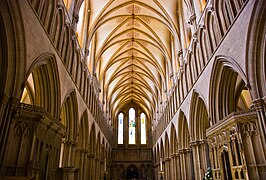


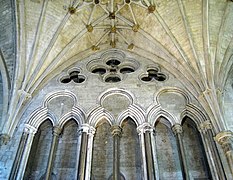
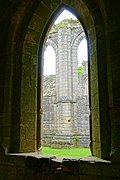












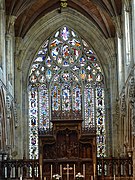


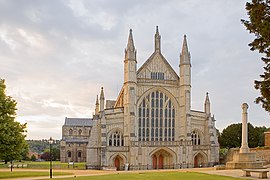


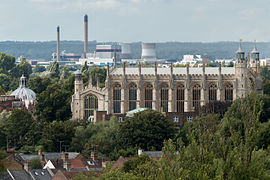
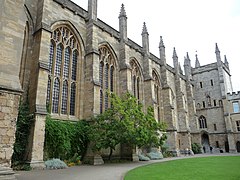
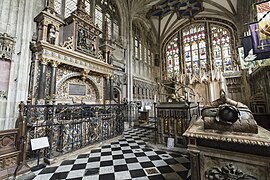
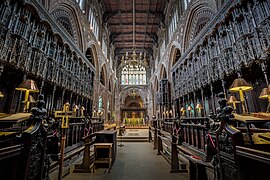

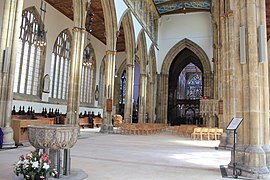



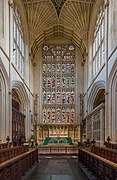





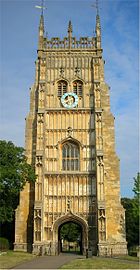
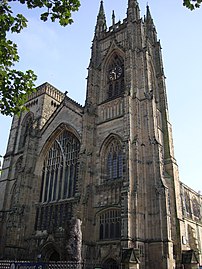
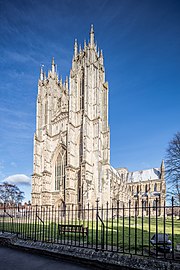
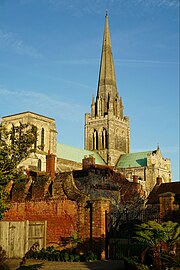





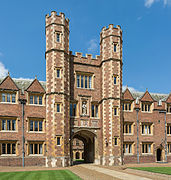


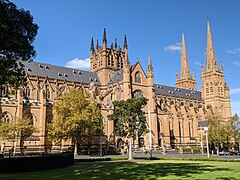


0 Response to "What Characteristic of British Early Medieval Art Appears in English Gothic"
Publicar un comentario